Italeri 1/72 SM.79 Sparviero
|
KIT #: |
1225 |
|
PRICE: |
$30.00 or so
|
|
DECALS: |
Four options |
|
REVIEWER: |
Pierre-André Boillat |
|
NOTES: |
A much acclaimed kit – but a rare sight at model shows. |
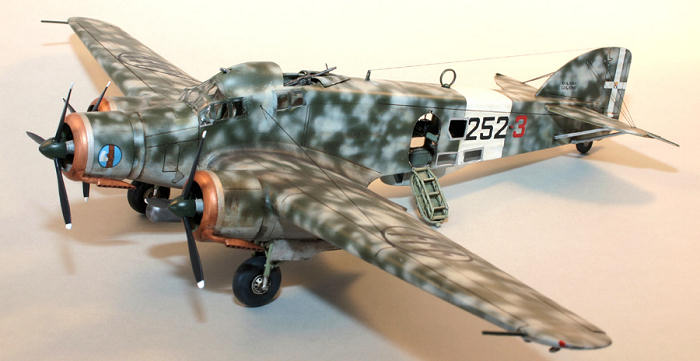
Unlike many pre-war German bomber types which
started their career pretending to be airliners or fast mail aircraft, the
Savoia Marchetti S.79 tri-motor was a
bona
fide
airliner which ended up as Italy’s best (and most famous)
bomber type of WWII.
Designed in 1933 by
Alessandro Marchetti as a fast passenger aircraft and first flown on
October 8, 1935,
the S.79 quickly made the headlines by breaking several world records.
Of course, some people at the
Regia Aeronautica
HQs at once saw the military potential of the new aircraft, whose performance
made the Air Force’s newest bomber, the SIAI S.81
Pipistrello
(then entering
production),
instantly obsolete. As a consequence, a military version of the S.79 was
commissioned… not without difficulties, as the tri-motor configuration was seen
as unpractical for bombers by many officials and twin-engined aircraft were
preferred for the task (one version, the S.79 B, was made in this f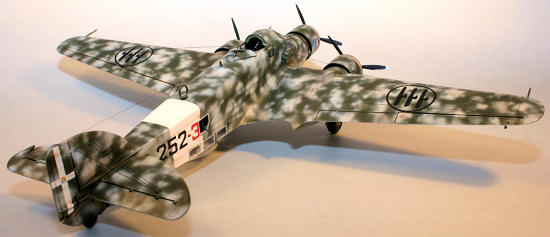 ashion,
but was rejected and only sold on export).
ashion,
but was rejected and only sold on export).
Eventually, the new
bomber took to the air for the first time on
July 8, 1936,
powered by three Alfa Romeo 125 engines. The most visible changes compared to
the airliner were the ventral gondola housing the bomb aimer, and of course the
streamlined dorsal hump containing defensive MGs which earned the aircraft the
nickname “il
gobbo” (the hunchback).
For the record, this
name - as well as the aircraft’s official designation “Sparviero”
(Sparrowhawk) - were hardly
ever used by the crews, who simply called their (beloved) planes “S.79”.
The aircraft entered
service in late ‘36 / early ’37, and saw a long and turbulent career from civil
war-torn Spain under Nationalist colours to the end of WWII, serving both the
Axis in the ANR and the Allies in the co-belligerant Air Force.
Though
conceived as a bomber, the S.79 is most famous as a torpedo aircraft, a role in
which this very stable and rugged machine excelled, the
Aerosiluranti
squadrons making the
Mediterranean
a dangerous place for Allied shipping until the 1943 armistice. Italian torpedo
bomber pilots enjoyed immense popularity, some reaching the “national hero”
status known only to fighter aces in other countries.
As a conclusion, one can say that this strange-looking, slow,
obsolescent aircraft was much better than its looks, and fully deserves its
place in History as an important and popular type.
First released a few years ago, Italeri’s S.79 was a much awaited kit,
as the only choice in this scale was an old model by Airfix which was not only
antique, but very hard to find. Paradoxally, 1/48 modellers were much better
served at the time, with Classic Airframes and Trumpeter both offering rather
good kits.
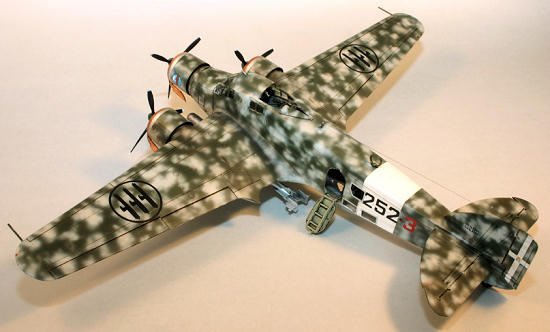 At
once, Italeri’s effort was very well received by the modelling world, being
generally accurate, well detailed for the scale and (at least in
Europe)
reasonably priced. The first boxing (which is the one reviewed here) depicts a
Regia Aeronautica torpedo aircraft, while the second issue’s subjects are bomber
versions (both Italian and Spanish Nationalist), the third featuring late war
torpedo versions of the ANR, all in dark green on gray or with black undersides.
At
once, Italeri’s effort was very well received by the modelling world, being
generally accurate, well detailed for the scale and (at least in
Europe)
reasonably priced. The first boxing (which is the one reviewed here) depicts a
Regia Aeronautica torpedo aircraft, while the second issue’s subjects are bomber
versions (both Italian and Spanish Nationalist), the third featuring late war
torpedo versions of the ANR, all in dark green on gray or with black undersides.
However, as stated
above, one hardly sees this model built (the only one I’ve seen “in the flesh”
so far was at a model show in southern
France,
brought by an Italian modeller).
The box contains two
main sprues totalling 80 well-molded parts, rather thick but clear
transparencies, and a very good decal sheet for four R.A. versions, carefully
picked to be interesting and to represent different levels of painting
difficulty. Small parts are a little on the thick side, but cockpit and interior
detail won’t be too visible anyway. On the plus side, engines and the exhaust
pipes are really nice. A little flash and an ejector pin mark here and there
will give you a little extra work, but nothing too bad.
One thing quickly turns out: the fuselage of the S.97 being full of
ports, windows, doors and other openings, its assembly is a little tricky and is
better prepared (by dry-fitting and deciding in advance what option you’ll go
for). Cockpit detail is decent for the scale (in my taste at least), and the
other fuselage areas (dorsal and central MG stands, top of the bomb bay, radio
compartment)
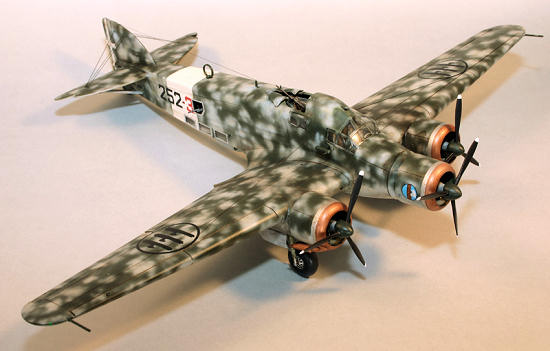 are good
enough for an OOB build and provide a good base for super-detailing. However,
although some care is required to install the inner parts, I found fit to be
quite good, and the fuselage becomes solid enough to withstand further
manipulation.
are good
enough for an OOB build and provide a good base for super-detailing. However,
although some care is required to install the inner parts, I found fit to be
quite good, and the fuselage becomes solid enough to withstand further
manipulation.
A few sink marks were
present on the inner fuselage walls and on some of the cockpit parts, which I
filled and sanded. Now that all’s closed, I think I could have done without the
extra work.
I installed the lower
fuselage windows and the transparent part of the bomb aimer position, then
masked them, except for the gunner ports’ windows, which were left out, as they
hardly ever were carried.
On the other hand,
the central MG was glued in place through the crew access door (with tweezers)
at the very end of the project, to avoid breakage – in spite of the fact that
the plastic is rather soft and not brittle at all.
The wings assemble
with ease and fit very well to the fuselage. I left the engines and their
cowlings aside until after the main filling and sanding session, and the landing
gears for the final assembly. Same goes for the tail plane struts. All in all,
the main airframe is put together easily and doesn’t require much “heavy work”
or lots of putty. Once this was done, I added the three engines, filled all
openings with moist tissue and went to the painting.
I chose one of the four options offered by Italeri:
one simple (plain dark olive over light grey), one with a very dense tri-colour
mottling, one in larger mottles with a grey nose and leading edges that’s very
nice but a bit too famous for my taste, and the one I picked: it is a machine of
252° Squadriglia A.S.
based at Rhodes in 1944, which in my opinion is the most elegant of the lot.
According to my documentation, it’s quite obvious that this aircraft must have
been at first in plain Italian dark olive over light blue
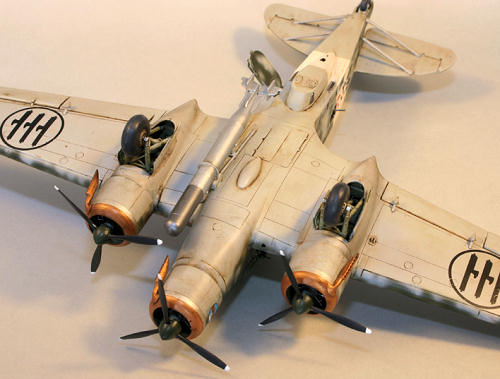 grey, with
a mottling of the undersides colour being sprayed later over the olive.
grey, with
a mottling of the undersides colour being sprayed later over the olive.
So, after spraying
and covering the copper cowling rings (the silver part would come later as decal
bands), I painted the aircraft using the same pattern. Here, I must say that,
while the Vallejo Air paints worked very well on the plain-coloured surfaces,
the mottling job with a 0.25mm nozzle proved impossible (at least with my Harder
& Steenbeck airbrush), due to instant clogging.
After many trials, I
eventually used my good old Tamiya acrylics for this part of the project.
Subsequent touch-ups with Vallejo showed that mottling is possible after all -
with the 0.35 nozzle, but not with the same precision, with the additional risk
of annoying droplets-spitting. As a result, I’ll keep my Vallejos for one-tone
or segmented schemes.
After the main paint
job was done, I sealed the model with a gloss coat and applied the decals, which
went on perfectly. Then I used my usual wash of oil paint to give the model a
weathered aspect.
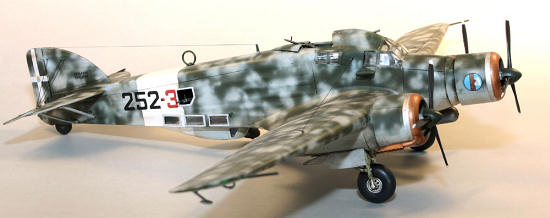 All
separately-painted “fiddly bits” were now ready for assembly: the landing gear,
props, struts, gear doors, machine guns, pitot tubes, etc. The sole torpedo (the
S.79 usually only carried one of these heavy and very effective weapons) was
painted in metallic tones, according to the few colour pics in my documentation.
Speaking of metallic tones, I used thin painted decal stripes to represent the
framing of the fuselage windows. Quite a job, but well worth it. Then, after a
slight weathering on these parts to “blend” them into the rest of the model, I
applied the final matte coat.
All
separately-painted “fiddly bits” were now ready for assembly: the landing gear,
props, struts, gear doors, machine guns, pitot tubes, etc. The sole torpedo (the
S.79 usually only carried one of these heavy and very effective weapons) was
painted in metallic tones, according to the few colour pics in my documentation.
Speaking of metallic tones, I used thin painted decal stripes to represent the
framing of the fuselage windows. Quite a job, but well worth it. Then, after a
slight weathering on these parts to “blend” them into the rest of the model, I
applied the final matte coat.
After this, I installed the main transparencies, which fit excellently.
As usual, I used painted decal stripes for the framing. The final touches were
some exhaust stains, the tail plane’s rigging, antenna wires and, last but not
least, the open crew access door which I left for the very end (I wonder how
many times I would have broken it if I hadn’t done so).
Ecco
- è finito questo.
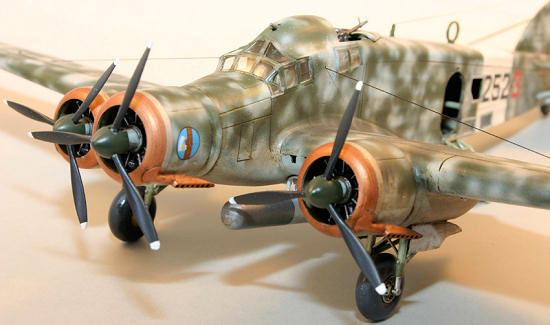 Though
not exactly the proverbial “shake-and-bake” kit, this one was not a difficult
project at all. A modeller with a little experience will have a good time
building it, and the super-detailing enthusiast will find it a sane and sound
base for further improvements. Above all, the model perfectly recaptures the
S.79’s characteristic shape, doing full justice to this important and
fascinating aircraft. In 1/72, it won’t take too much display space – a good
thing, considering that the many superb and colourful schemes sported by the
Sparviero throughout its career are a strong motivation to build more of these
three-engined birds.
Though
not exactly the proverbial “shake-and-bake” kit, this one was not a difficult
project at all. A modeller with a little experience will have a good time
building it, and the super-detailing enthusiast will find it a sane and sound
base for further improvements. Above all, the model perfectly recaptures the
S.79’s characteristic shape, doing full justice to this important and
fascinating aircraft. In 1/72, it won’t take too much display space – a good
thing, considering that the many superb and colourful schemes sported by the
Sparviero throughout its career are a strong motivation to build more of these
three-engined birds.
Highly recommended to
all but absolute beginners.
-
Savoia
Marchetti S.79 in Action # 71
-
Warpaint Series # 61 : S.79
Pierre-André
Boillat
April 2011
If you would like your product reviewed fairly and quickly, please
contact
me or see other details in the
Note to
Contributors.
Back to the Main Page
Back to the Review
Index Page


 ashion,
but was rejected and only sold on export).
ashion,
but was rejected and only sold on export).
 are good
enough for an OOB build and provide a good base for super-detailing. However,
although some care is required to install the inner parts, I found fit to be
quite good, and the fuselage becomes solid enough to withstand further
manipulation.
are good
enough for an OOB build and provide a good base for super-detailing. However,
although some care is required to install the inner parts, I found fit to be
quite good, and the fuselage becomes solid enough to withstand further
manipulation. grey, with
a mottling of the undersides colour being sprayed later over the olive.
grey, with
a mottling of the undersides colour being sprayed later over the olive.
 All
separately-painted “fiddly bits” were now ready for assembly: the landing gear,
props, struts, gear doors, machine guns, pitot tubes, etc. The sole torpedo (the
S.79 usually only carried one of these heavy and very effective weapons) was
painted in metallic tones, according to the few colour pics in my documentation.
Speaking of metallic tones, I used thin painted decal stripes to represent the
framing of the fuselage windows. Quite a job, but well worth it. Then, after a
slight weathering on these parts to “blend” them into the rest of the model, I
applied the final matte coat.
All
separately-painted “fiddly bits” were now ready for assembly: the landing gear,
props, struts, gear doors, machine guns, pitot tubes, etc. The sole torpedo (the
S.79 usually only carried one of these heavy and very effective weapons) was
painted in metallic tones, according to the few colour pics in my documentation.
Speaking of metallic tones, I used thin painted decal stripes to represent the
framing of the fuselage windows. Quite a job, but well worth it. Then, after a
slight weathering on these parts to “blend” them into the rest of the model, I
applied the final matte coat.